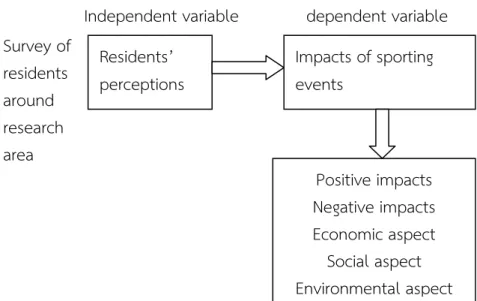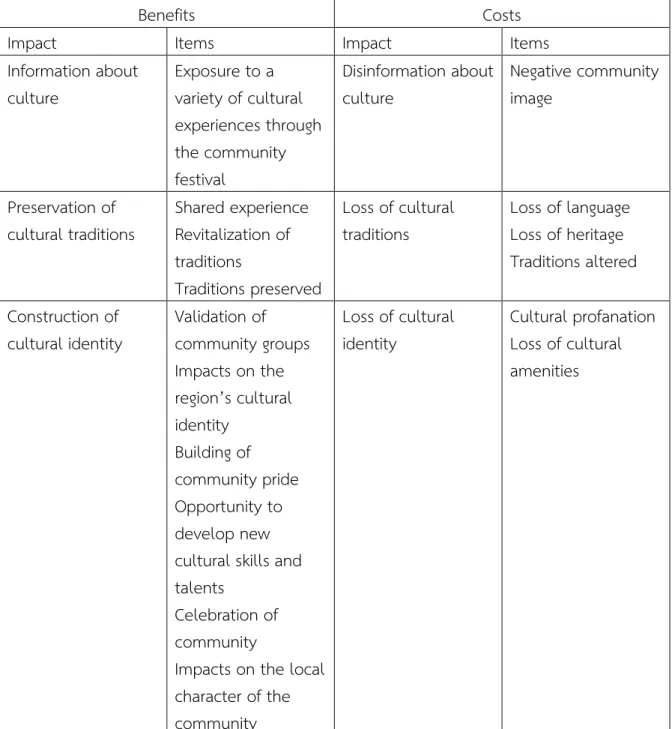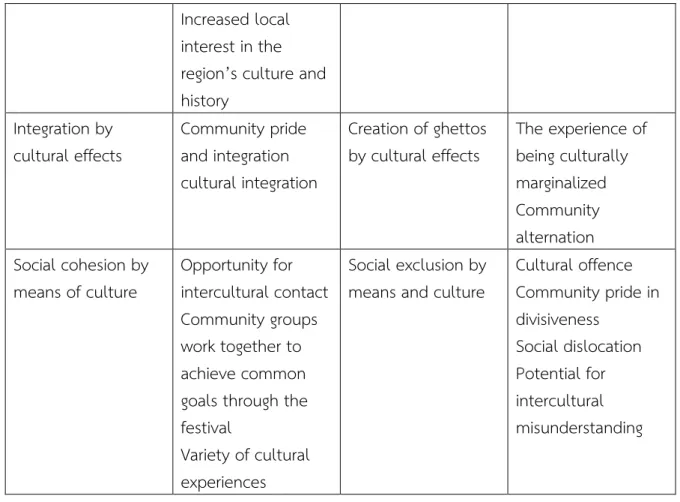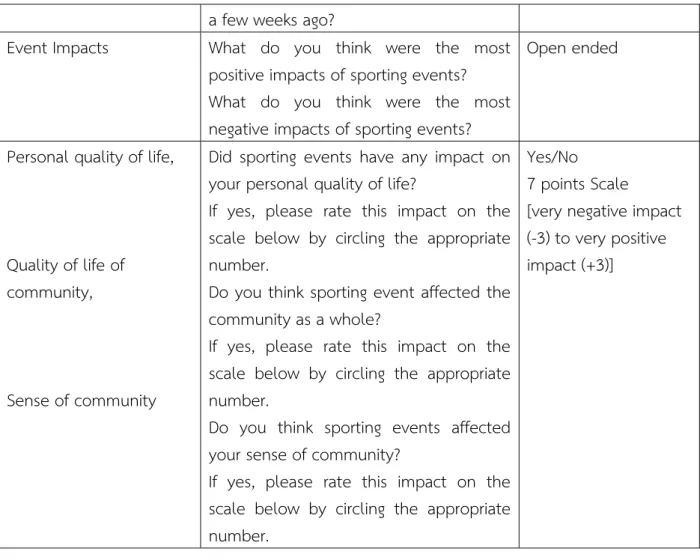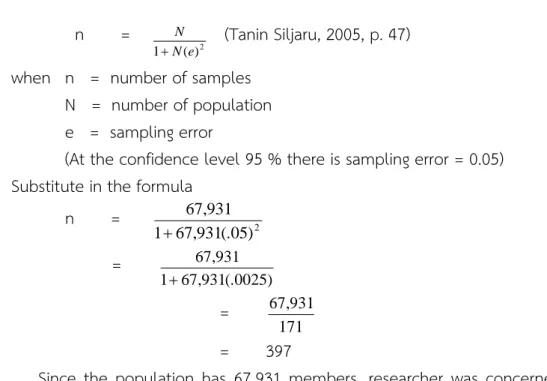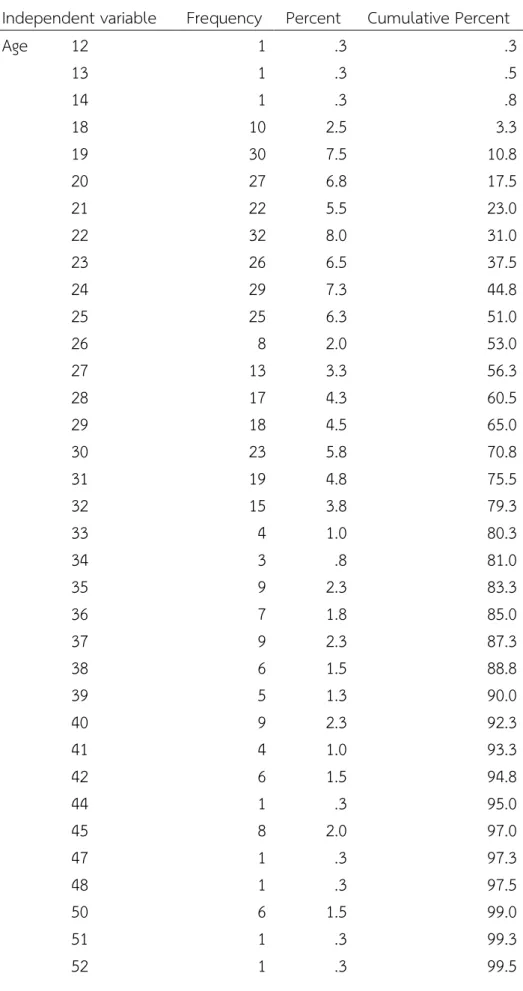หัวข้องานวิจัย: การสำรวจการรับรู้ของผู้อยู่อาศัยเกี่ยวกับผลกระทบของการแข่งขันกีฬา ชื่อโครงการวิจัย: การสำรวจการรับรู้ของผู้อยู่อาศัยเกี่ยวกับผลกระทบของการแข่งขันกีฬา การวิจัยครั้งนี้มีวัตถุประสงค์เพื่อเน้นการวัดประสิทธิภาพการแข่งขันกีฬาต่อผลกระทบเชิงบวกและเชิงลบ ใช้สถิติเชิงพรรณนา เพื่ออธิบายรายวิชาและการรับรู้ผลกระทบของการแข่งขันกีฬา
It aims to investigate the perceptions of people living around the Rajamangala National Stadium regarding the impact of sporting events on the community. The purpose of this research is to focus on measuring the performance of sporting events against positive and negative impacts Rajamangala National Stadium is the national stadium of Thailand and the home stadium for the Thailand national football team. Results of Residents' Awareness of Sporting Events 25 Sporting Event Created Positive and Negative Impacts: A Qualitative Approach 25 Perceptions of Sporting Events and Social Impacts 27 Characteristics of Respondents' Involvement 30.
The influence of the environment on a sporting event is more tangible and direct, which affects the distribution of certain sporting events according to the suitability of the climate and physical environment of each place. The aim of the research project is to investigate the perception of people living near the Rajamangala National Stadium regarding the impact of sporting events on the community. The scope of the content focused on measuring the performance of sporting events in terms of positive and negative impacts, including economic, social and environmental aspects.
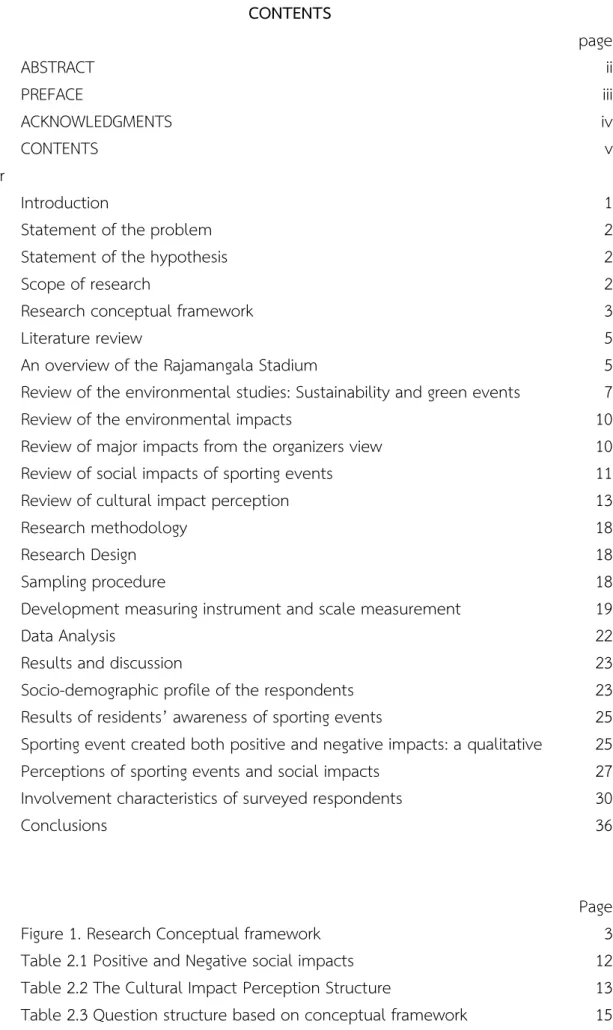
LITERATURE REVIEW
An overview of the Rajamangala Stadium (Wikipedia, Access on May 1, 2017)
East is an uncovered popular side; 'West' is the covered side where the more expensive seats are. The stadium is not accessible by public transport, which has always been a source of frustration for fans. Bangkok Skytrains, subways or regular overhead trains do not stop anywhere near the stadium (unlike Suphachalasai Stadium which is served by the Skytrain - National Stadium Station).
But in 2010, the Suvarnabhumi Airport Link was completed, meaning the stadium is connected by the City Line at Ramkhamhaeng Station. Other stadiums in Bangkok include the Thai Army Sports Stadium, the Thailand-Japan Stadium and the Chulalongkorn University Stadium. Full Name Rajamangala National Stadium Location Bang Kapi, Bangkok, Thailand Coordinates 13°45′20″N 100°37′20″E ARL Ramkhamhaeng Public Transport Station.
Review of the environmental studies: Sustainability and green events
The second phase of the study was a three-round, customized, web-based Delphi survey of event experts. The aim was to use the opinions of the event experts to develop a collection of indicators to measure the most important impact. Once a subset of the indicators had been selected, the third phase of the research involved conducting two case studies on special events.
After this, the fourth major phase of the research involved consultations with a small number of project stakeholders to get feedback on the indicators used and the results of one of the case studies. In general, the stakeholders supported both the direction of the research and the use of the TBL indicators to evaluate the impact of events. Therefore, the inclusion of environmental measures will give a clearer picture of an event's environmental footprint.
Residents' perceptions of the certification were positively related to their overall attitude towards the event.
Review of major impacts from the organizers view
Review of social impacts of sporting events
If so, please rate this impact on the scale below by circling the appropriate number. Interest in Event On the scale below, please indicate how interested you are in football events. Involvement Please indicate whether any of the following apply to you or another member of your household.
Work for or own a company that is involved in football events (eg goods or services supplied, sponsor). The dependent variable involves measuring the impacts of residents' perceptions of the performance of community sporting events. It involves collecting data to answer questions about the impacts of sporting events on the host community.
Qualitative method helped to identify variables involves measuring residents' perception impact of sports event performance among subjects. What type of impact, it can be related to society's economic, social or environmental. This research calculates the size of the sample when we know the population and uses the formula to calculate as follows.
The reason for using the additional questions was that a survey using only the four social indicators obtained from this study would be too short. Additional questions not only added to the quality of the survey instrument, but also allowed some of the other social issues to be addressed, such as the level of community involvement in the event. Please indicate whether any of the following apply to you or another member of your household (select all that apply).
Work in other events Your Household Member Not applicable Work in the hospitality industry Your Household Member Not applicable Participated in football events as a. The third and final part of the instrument included questions about attendance at current or past football events, level of interest in event, type of involvement in event by respondent or household member, and participants' distance, gender and age. The second section presents the results obtained from residents' awareness of sports events, positive and negative impacts through qualitative approach, residents' perceptions impact of sports events' performance on the community, and characteristics of surveyed respondents related to sports events through descriptive statistics .
What type of impact, it can be related to society's economic, social or environmental.
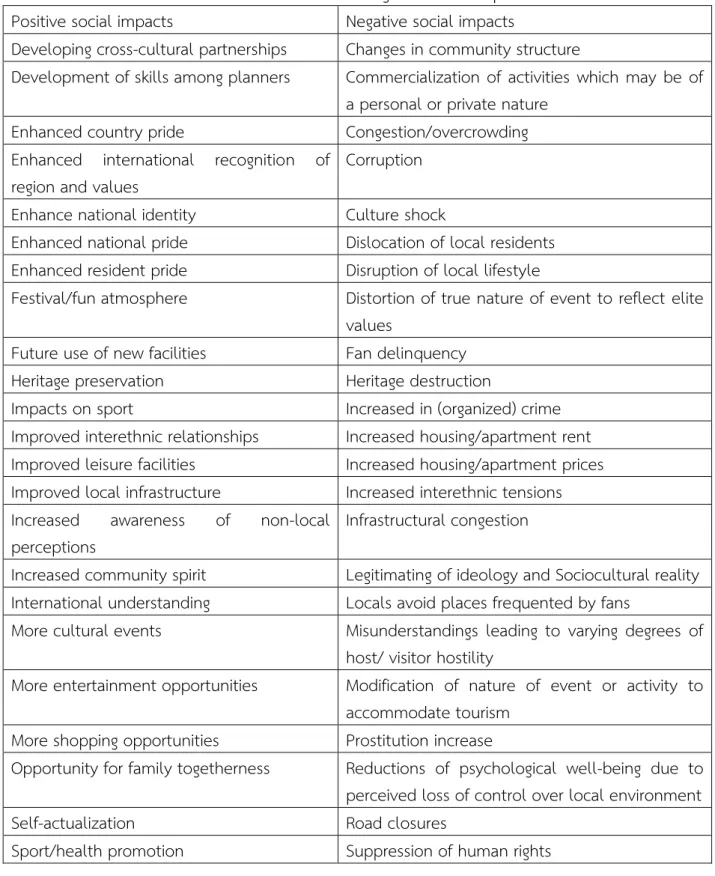
Socio-demographic profile of the respondents
Results of residents’ awareness of sporting events
Sporting event created both positive and negative impacts: a qualitative approach The residents were asked to list the most positive impacts and negative
In addition, during the major sporting events, thousands of people may go to the host community to watch it. They can also buy hotel rooms, meals, drinks, transportation, tickets to the games or matches, etc. This means that sporting events increase spending and promote an increase in retail sales, which is very beneficial to the host economy.
The findings were identified as four key positive impacts; recreation, location and infrastructure development, entertainment and economic benefits, different from. After positive impacts were identified, residents were asked, “What do you think were the most negative impacts of sporting events?” The purpose of this question was to determine the perceived impact of sporting events and to distinguish these impacts, which have not previously been addressed in the existing literature. Sporting events also have negative impacts on the host community, including heavy traffic congestion, inconvenience for transportation, overcrowding, disruptions to the normal lives of residents and displacement of the local community.
The findings identified the negative impact of sporting events on the environment due to increased pollution, noise pollution, air pollution and too much garbage.
Perceptions of sporting events and social impacts
Regarding the personal quality of life, 82.3 percent of the respondents agree that sports events have no impact on the quality of their personal life, although 17.8 percent of the respondents have perceived an impact on the personal quality of their life. However, most of them, 85.3 percent, agree that the impact on the quality of life is at a neutral level. After that, “If yes, please rate this impact on the scale below by circling the appropriate number.
This item comes with a 7-point rating scale from very negative effect (-3) to very positive effect (+3). The respondents' perceptions of quality of life in the community are presented in table 4.6-table 4.7. But most of them, 81.3 percent agreed that sporting events impact on the quality of life in society is neutral level.
Residents were asked, "Do you think sporting events affected your sense of community?" After the,. In relation to the sense of community, 83.5 percent of the respondents agree that the sporting event has no influence on the sense of community, although 16.5 percent of. Residents were asked, "Do you think sporting events affected your pride in your community?" Then, “If yes, please rate this impact on the scale below by circling the appropriate number.
In relation to community pride, 79.5 percent of respondents agreed that sporting events have no impact on community pride, although 20.5 percent of respondents perceived impact on community pride. However, most of them, 85.8 percent, agreed that the impact of sporting events on community pride is at a neutral level.
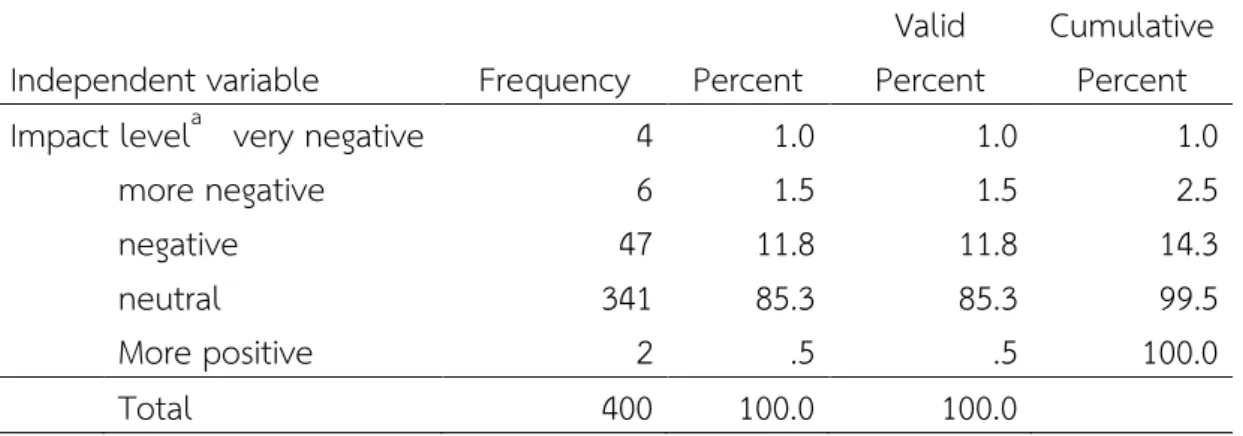
Involvement characteristics of surveyed respondents
Regarding the age of the respondents, the majority of them (54.3 percent) are between 20-29 years old. Taking into account the attendance in previous years, 66 percent of the respondents had not attended a sporting event in previous years. Regarding those interested in football event, an interesting fact can be noted: the vast majority (29.5 percent) are interested in football event and follow when they can.
20.3 percent of respondents were not interested in football, but sometimes went to or watched football. 14.5 percent of respondents were not particularly interested in football events, but football is an enjoyable experience. Looking at the engagement characteristics of respondents surveyed, 2.7 percent of respondents worked at football events in 2017.
There are 1.5 percent of the respondents had worked at football events (either paid or voluntary) in previous years. There is 1 percent of respondents work for or own a business involved in football events (eg goods or services provided, sponsor). There are 1.8 percent of respondents receiving benefits in some way (eg rented a property to a visitor for football events).
Analyzing proximity, an interesting fact can be noted: the vast majority (36.3 percent) live 1-5 km from the Rajamangala National Stadium. Regarding awareness of sports event news, 54.5 percent of respondents saw the news and 45.5 percent did not perceive it. Regarding sense of community, 83.5 percent of respondents agree that sporting event has no impact on sense of community, although 16.5 percent of respondents experienced an impact on sense of community.
However, the majority of them, 87.0 percent, agreed that the sporting events' impact on the sense of community is at a neutral level. Considering the engagement characteristics of surveyed respondents, 2.7 percent of the respondents work at football event in the year 2017. If the analysis of proximity, an interesting fact can be noted: the vast majority (36.3 percent) live 1- 5 km from the Rajamangala National Stadium.
Considering the distance of 6 to 10 km from the Rajamangala National Stadium, 14.8 percent of the respondents stayed in this area.

